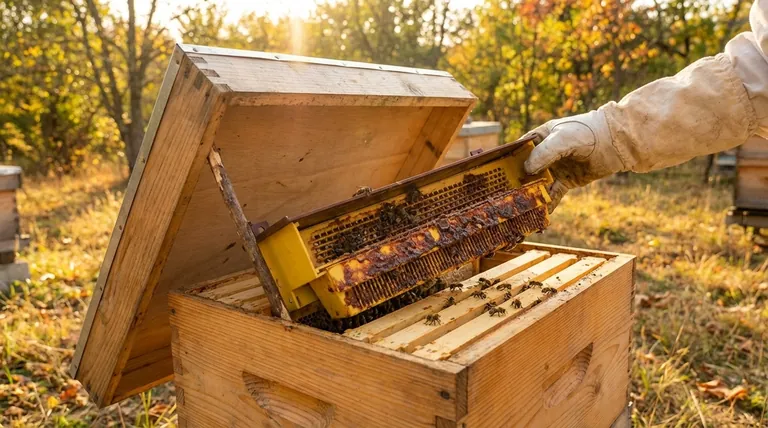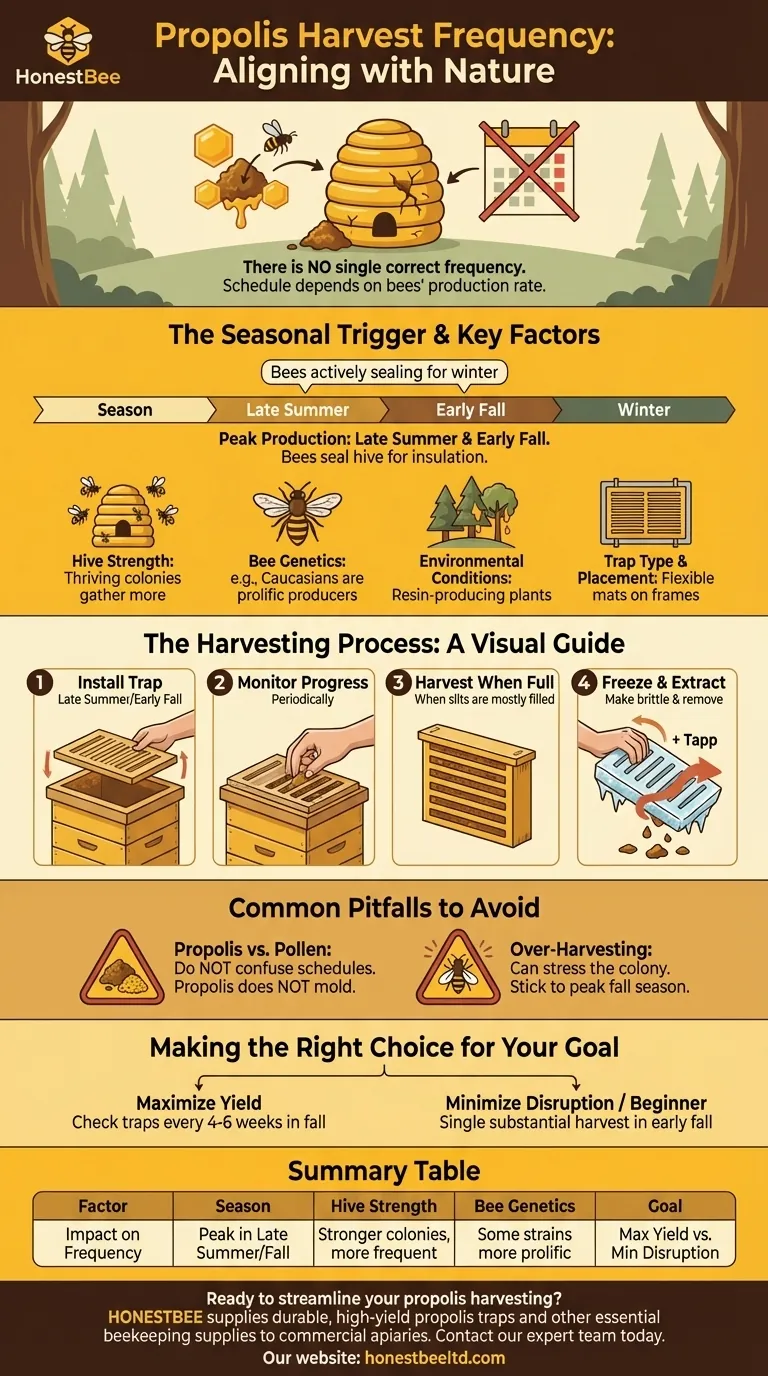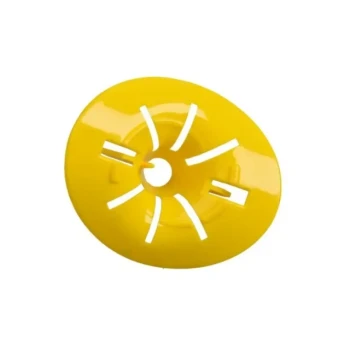There is no single correct frequency for harvesting propolis traps. The optimal schedule can range from every four weeks to just once per year, as it is determined by the bees' own production rate. This rate is influenced by hive strength, bee genetics, weather, and the availability of resin-producing plants in your area.
The key to successful propolis harvesting is not adhering to a strict calendar, but rather understanding and aligning with the bees' natural behavior. Your focus should be on installing traps during the peak production season—late summer and early fall—and harvesting only when the traps are sufficiently filled.

The Seasonal Trigger for Propolis Production
To harvest propolis effectively, you must first understand why and when bees produce it. Propolis is a resinous mixture that bees use as a sealant, structural reinforcer, and antimicrobial agent to protect the hive.
The Hive's Need for Insulation
As temperatures begin to drop in late summer and early fall, bees instinctively begin to winterize their home. Their primary goal is to seal any cracks or drafts to maintain a stable internal temperature throughout the winter.
Peak Production Window
This natural drive to seal the hive triggers a significant increase in propolis production. By placing a trap on the hive during this period, you are simply taking advantage of a natural behavior that is already in full swing. This is the most productive and least disruptive time to encourage propolis collection.
Key Factors Influencing Your Harvest Schedule
While the season dictates the best time to harvest, several other factors determine how often you can harvest within that window.
Hive Strength and Genetics
A large, thriving colony with a strong workforce will naturally gather more resources, including propolis. Additionally, some strains of honey bees, like Caucasians, are known to be more prolific propolis producers than others.
Environmental Conditions
The availability of resin-producing trees is critical. Bees primarily gather resins from the buds of trees like poplars, pines, birches, and conifers. An environment rich in these sources will lead to a faster harvest.
Trap Type and Placement
Most propolis traps are flexible plastic mats with small slits or grooves. They are placed directly on top of the frames, replacing the inner cover. Propping the outer cover open slightly allows light and air in, which the bees perceive as a "draft" they need to seal, encouraging them to fill the trap's slits with propolis.
The Harvesting Process: A Visual Approach
Instead of relying on a calendar, let the state of the trap be your guide.
Step 1: Install the Trap
Place the propolis trap on the hive in late summer or early fall as the bees begin their winter preparations.
Step 2: Monitor Its Progress
Periodically check the trap. There is no need for a rigid four-week schedule. Simply observe how quickly the bees are filling the slits. For some hives, this may take a month; for others, it might take the entire season.
Step 3: Harvest When Full
Once you see that the majority of the slits in the trap have been filled with propolis, it is time to harvest. The bees have completed the work for you.
Step 4: Freeze and Extract
Remove the trap and place it in a freezer for several hours. This makes the propolis extremely brittle. Once frozen, you can easily remove the propolis by twisting the flexible mat or tapping it against a hard surface, causing the propolis to break off cleanly.
Common Pitfalls to Avoid
Understanding the nuances of harvesting is critical for both yield and hive health.
Propolis vs. Pollen: A Critical Distinction
Do not confuse the harvesting schedules for propolis and pollen. Pollen must be harvested daily to prevent mold and pests. Propolis, however, is a powerful antimicrobial and preservative. It will not mold in the trap and does not require frequent collection.
Over-Harvesting and Hive Stress
Propolis is essential for the colony's immune system and structural integrity. Removing it excessively or at the wrong time of year can stress the bees. Limiting your harvesting to the peak fall season ensures the bees have already met their own needs for winterization.
Making the Right Choice for Your Goal
Base your harvesting strategy on your specific objectives and experience level.
- If your primary focus is maximizing yield: During the peak fall season, check your traps every 4-6 weeks and harvest whenever they appear full.
- If your primary focus is casual harvesting with minimal disruption: Install a trap in early fall and plan for a single, substantial harvest before winter fully begins.
- If you are a beginner: Start with the single-harvest method. This allows you to learn the process and observe your bees' production rate without adding unnecessary stress to the colony.
By aligning your efforts with the bees' natural rhythms, you can achieve a successful propolis harvest while supporting a healthy, thriving colony.
Summary Table:
| Factor | Impact on Harvest Frequency |
|---|---|
| Season | Peak production in late summer/fall; harvest only during this window. |
| Hive Strength | Stronger colonies fill traps faster, allowing for more frequent harvests. |
| Bee Genetics | Some strains (e.g., Caucasians) are more prolific producers. |
| Goal | Maximize yield (harvest every 4-6 weeks) or minimize disruption (single annual harvest). |
Ready to streamline your propolis harvesting?
HONESTBEE supplies durable, high-yield propolis traps and other essential beekeeping supplies to commercial apiaries and distributors. Our wholesale-focused operations ensure you get the reliable equipment you need to support healthy, productive colonies.
Contact our expert team today to discuss your specific needs and boost your operation's efficiency.
Visual Guide

Related Products
- Removable Plastic Pollen Trap With Ventilated Tray for Bees Pollen Collector
- Reusable Wasp Trap Bottle Converter
- Gourd Shaped Hanging Wasp Trap Professional Wasp Catcher
- All-Stainless Steel Pivoting Honey Uncapping Fork for Beekeeping
- Professional Bucket Style Wasp and Moth Pheromone Trap
People Also Ask
- What are the primary reasons beekeepers collect bee pollen? Boost Hive Health and Generate Income
- What are the main types of pollen traps? Choose the Right Design for Your Hive's Health
- How do bees adjust to a new pollen trap entrance? Ensure a Smooth Transition for Your Hive
- What is a pollen trap and how does it work? A Guide to Harvesting Bee Pollen
- What are the different types of pollen traps available? A Guide to Front-Porch & Bottom-Mounted Designs



















